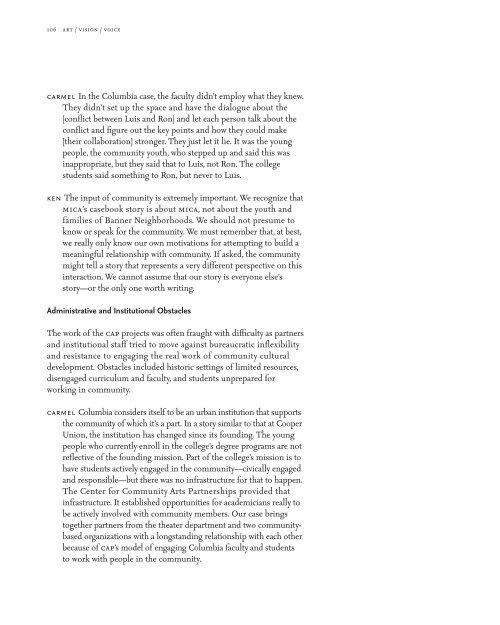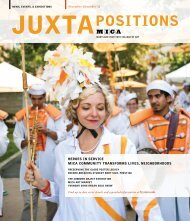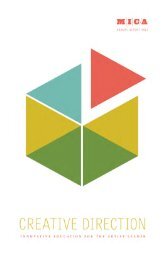art/vision/voice - Maryland Institute College of Art
art/vision/voice - Maryland Institute College of Art
art/vision/voice - Maryland Institute College of Art
Create successful ePaper yourself
Turn your PDF publications into a flip-book with our unique Google optimized e-Paper software.
106 <strong>art</strong> / <strong>vision</strong> / <strong>voice</strong><br />
carmel In the Columbia case, the faculty didn’t employ what they knew.<br />
They didn’t set up the space and have the dialogue about the<br />
[conflict between Luis and Ron] and let each person talk about the<br />
conflict and figure out the key points and how they could make<br />
[their collaboration] stronger. They just let it lie. It was the young<br />
people, the community youth, who stepped up and said this was<br />
inappropriate, but they said that to Luis, not Ron. The college<br />
students said something to Ron, but never to Luis.<br />
ken The input <strong>of</strong> community is extremely important. We recognize that<br />
mica’s casebook story is about mica, not about the youth and<br />
families <strong>of</strong> Banner Neighborhoods. We should not presume to<br />
know or speak for the community. We must remember that, at best,<br />
we really only know our own motivations for attempting to build a<br />
meaningful relationship with community. If asked, the community<br />
might tell a story that represents a very different perspective on this<br />
interaction. We cannot assume that our story is everyone else’s<br />
story—or the only one worth writing.<br />
Administrative and Institutional Obstacles<br />
The work <strong>of</strong> the cap projects was <strong>of</strong>ten fraught with difficulty as p<strong>art</strong>ners<br />
and institutional staff tried to move against bureaucratic inflexibility<br />
and resistance to engaging the real work <strong>of</strong> community cultural<br />
development. Obstacles included historic settings <strong>of</strong> limited resources,<br />
disengaged curriculum and faculty, and students unprepared for<br />
working in community.<br />
carmel Columbia considers itself to be an urban institution that supports<br />
the community <strong>of</strong> which it’s a p<strong>art</strong>. In a story similar to that at Cooper<br />
Union, the institution has changed since its founding. The young<br />
people who currently enroll in the college’s degree programs are not<br />
reflective <strong>of</strong> the founding mission. P<strong>art</strong> <strong>of</strong> the college’s mission is to<br />
have students actively engaged in the community—civically engaged<br />
and responsible—but there was no infrastructure for that to happen.<br />
The Center for Community <strong>Art</strong>s P<strong>art</strong>nerships provided that<br />
infrastructure. It established opportunities for academicians really to<br />
be actively involved with community members. Our case brings<br />
together p<strong>art</strong>ners from the theater dep<strong>art</strong>ment and two communitybased<br />
organizations with a longstanding relationship with each other<br />
because <strong>of</strong> cap’s model <strong>of</strong> engaging Columbia faculty and students<br />
to work with people in the community.
















